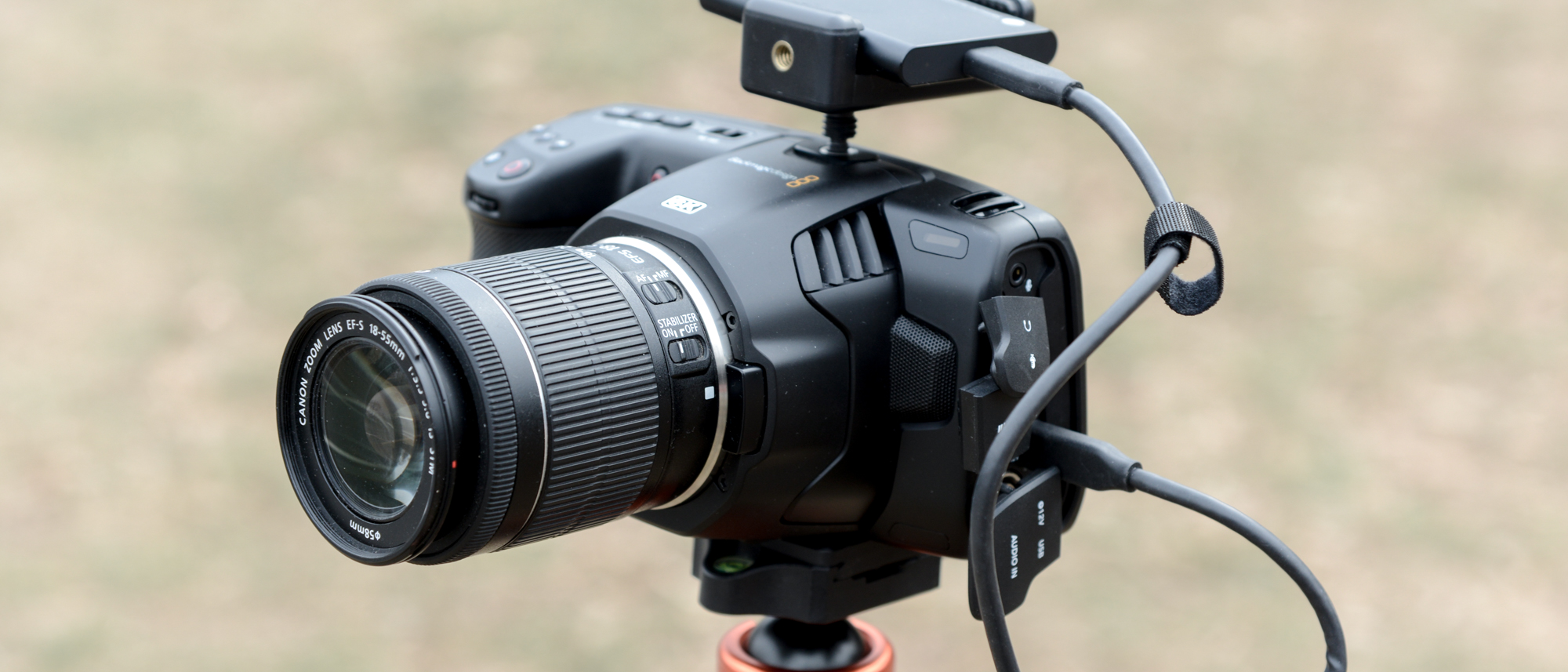Laptop Mag Verdict
The Blackmagic Pocket Cinema 6K is an affordable cinema camera that will level up your content creation, video, and film production
Pros
- +
6K resolution and 120fps in 2.6K
- +
Excellent footage quality
- +
Davinci Resolve Software
- +
Fantastic port selection
- +
Relatively affordable
Cons
- -
Poor Battery Life
- -
Rudimentary autofocus
Why you can trust Laptop Mag
Price: $1,995
Sensor: Super 35
Dynamic range: 13 stops
Resolution (Blackmagic RAW): (60fps) 6144 x 3456 (6K), 6144 x 2560 (6K 2.4:1), 5744 x 3024 (5.7K 17:9) (120fps) 2.8k, 1080p HD
Resolution (ProRes): 3840 x 2160 (Ultra HD), 2868 x 1512 (2.8K 17:9), 1920 x 1080 (HD)
Lens Mount: Canon EF
Display: 5-inch1920 x 1080 LCD touch screen
Storage: Dual SD/CFast cards, records RAW internally, external recording to USB-C drive
Construction: Polycarbonate/carbon fibre composite
Battery: LP‑E6 Battery with USB-C charging
Power: Lockable DC port Weipu 2-pin connector
Size: 9.1 x 9.1 x 9.1 inches
Weight: 1.98 pounds
Many terms and platitudes can be used to describe what Blackmagic is doing and has done. Game-changing and disruptive are two of them, and the Blackmagic Pocket Cinema 6K, which was first released in 2019, fully encompasses both. When you build a camera that films quality footage on or near the level of industry giants like Red, Arri, and Canon then sell it at a price most can afford, you are indeed changing the game.
The Blackmagic Pocket Cinema 6K (BMPC6K) has the appearance of a beautiful black DSLR camera. Yes, you can take some lovely photos with it, but it is a robust cinema camera created to give everyone a shot at making their celluloid dreams come true.
Since its release, content creators, documentarians, students, indie filmmakers, and major studios have been making the most of its 6K resolution and RAW footage capture capabilities, making it a favorite go-to for many in the know.
Blackmagic Pocket Cinema 6K pricing and configurations
The Blackmagic Pocket Cinema 6K (6144 x 3456) costs $1,995 and comes with a 5-inch touch-capacitive 1920 x 1080-pixel HD display, a Super 35 image Sensor, 13 stops of dynamic range, A Canon EF lens mount, and dual native ISO up to 25,600 for HDR images and low light performance.
Blackmagic Pocket Cinema 6K design
The Blackmagic Pocket Cinema 6K has a similar form factor to many popular DSLR cameras on the market, but it’s a little huskier. It is made of a black polycarbonate/carbon fiber composite, making it lightweight with a right-handed grip that fits nicely in your hand. There are two tripod mounts at the top and bottom to provide users with mounting options for things like an audio recorder, an SSD, or, you guessed it, a tripod.
On the top right-hand side of the camera, you’ll find the record start and stop button with the still photo button next to it. There are buttons for ISO, shutter speed, and white balance behind the previously mentioned buttons. There are also three customizable function buttons, which you can program to toggle zebra, grid lines, or LUT previews so you can see what you’re shooting might look like after you grade it with Davinci Resolve, which comes free with the camera.
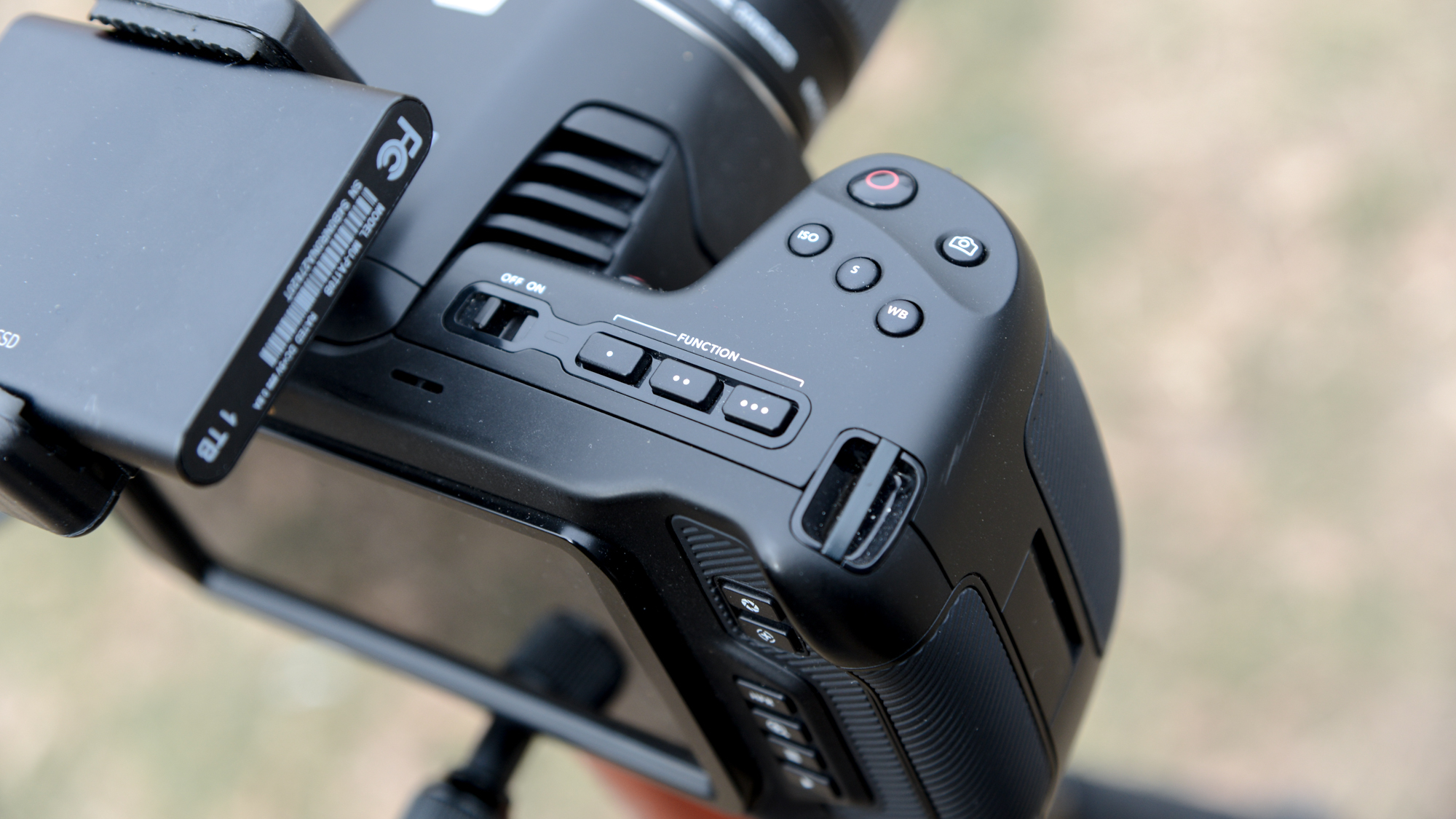
The shooter also has built-in stereo microphones that do a solid job but are best used for syncing video with an external audio recorder.
Sign up to receive The Snapshot, a free special dispatch from Laptop Mag, in your inbox.
On the right side of the camera is a door covering the SD and CFast 2.0 card slots. The left side of the camera is where all of the ports reside. The port covers are made of a solid rubber material and pop on or off easily while remaining attached to the camera. Along the camera's bottom is a battery door, a tripod mount, and the fan’s vent, which keeps the camera nice and cool.
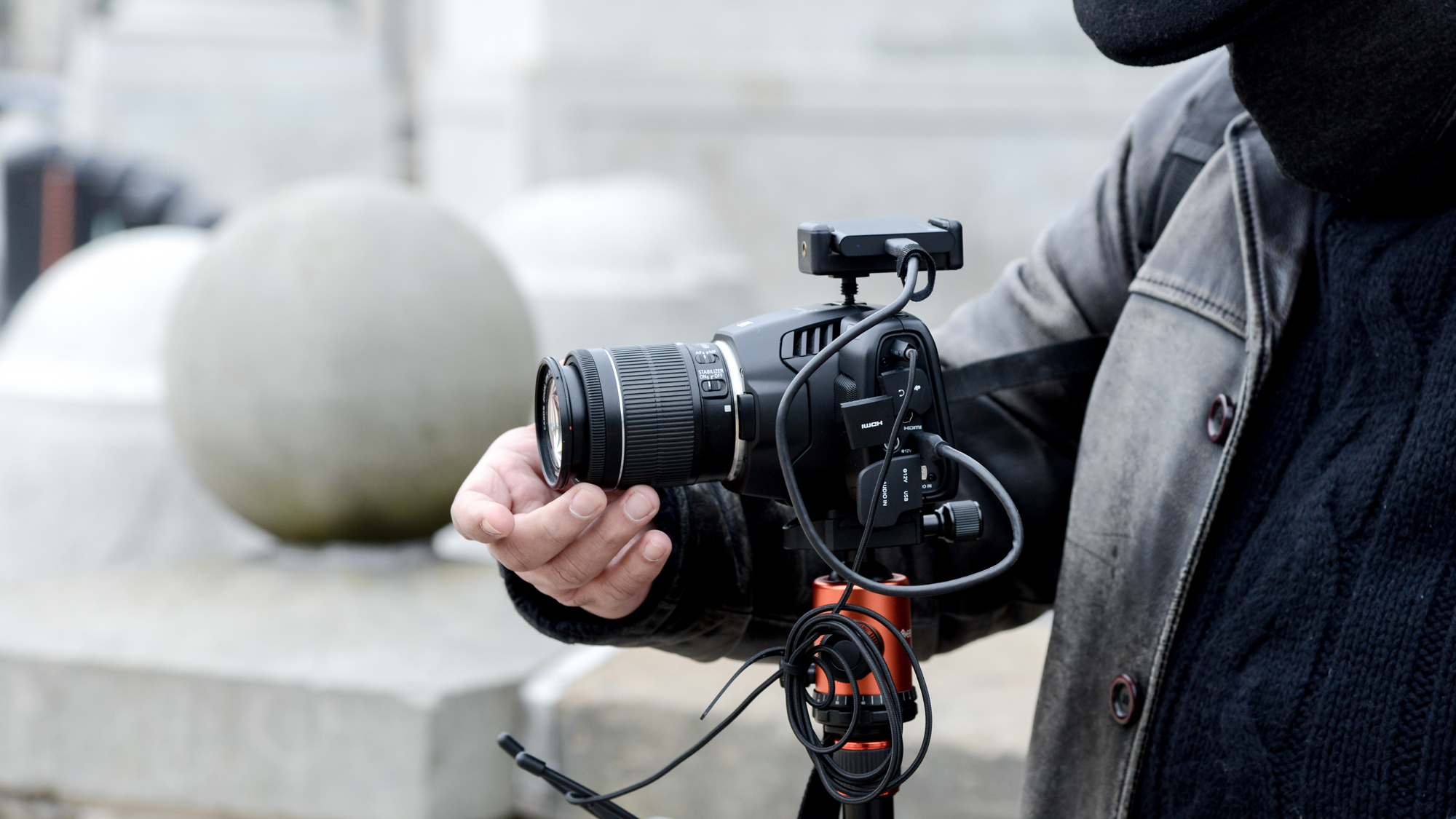
Measuring 9.1 x 9.1 x 9.1 inches and weighing 2 pounds, the Blackmagic Pocket Cinema 6K may appear to be a DSLR’s chubbier cousin, but it’s relatively lightweight. When you see the quality of the footage you’re getting at a much lighter weight than cameras like a Red, Arri, or Canon C300, your back and arms will thank you. It’s truly a grab-and-go design that grants the user a great deal of freedom and can be mounted to everything from cars to drones.
Blackmagic Pocket Cinema 6K ports
All the ports on the BMPC6K are on the left side of the camera, where you’ll find a 3.5mm stereo mic jack, a 3.5mm headphone jack, a full-sized HDMI-out, a locking 12-volt power supply, a USB-C port, and a mini XLR-in with phantom power support for high-quality audio.
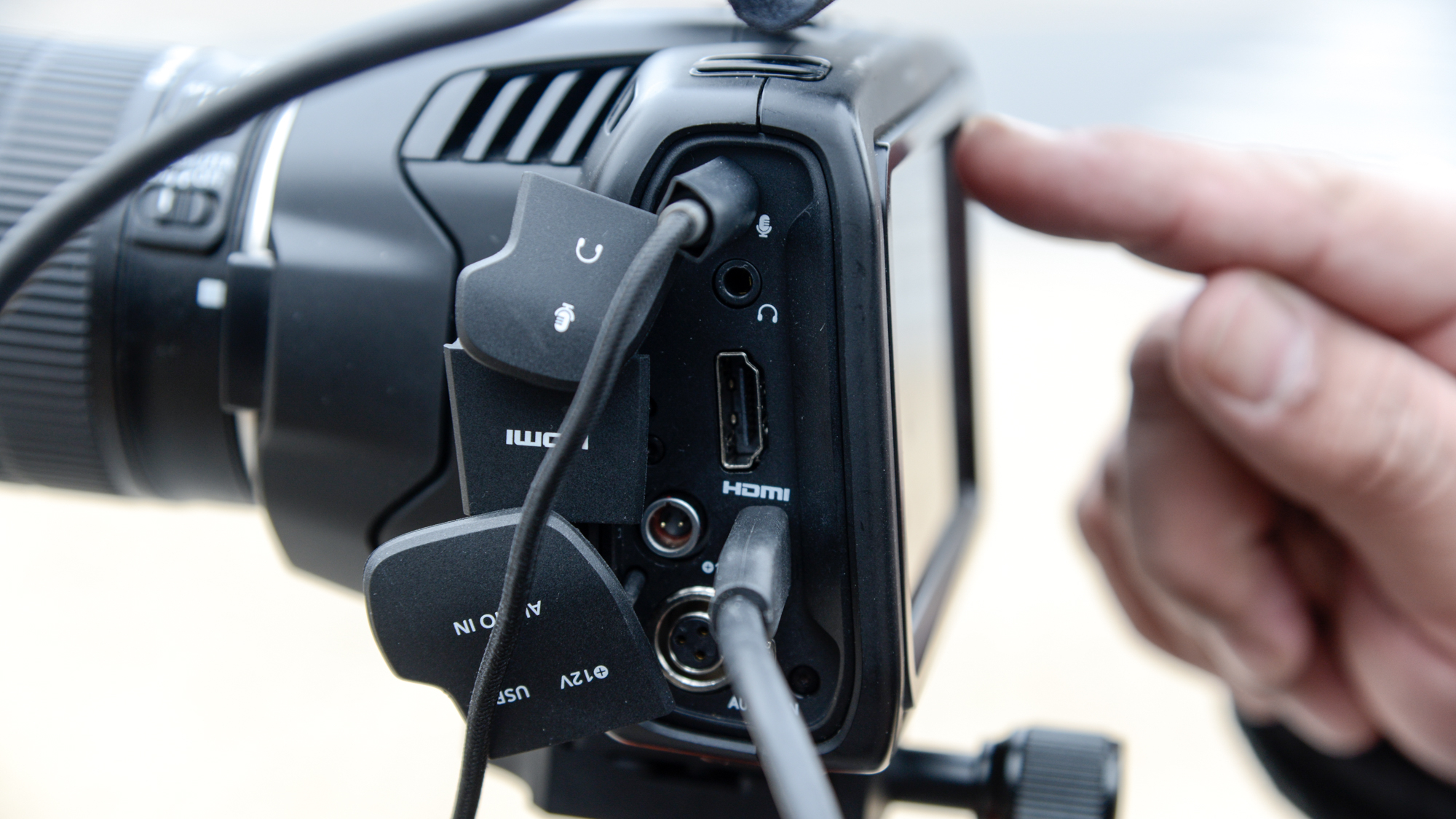
Blackmagic Pocket Cinema 6k Storage options
When filming at 6K at 12 bits, you’re eating up a lot of memory very quickly. With the BMPC6K, you have several storage options starting with an SD slot and the CFast cards. But my favorite and the most efficient to connect an SSD via the USB-Type C port of the camera.

Today, SSDs are so affordable you can purchase them for less than many CFast cards, and you won’t need a card reader to upload your footage after. Just plug it into your computer’s USB-Type C port and off to work you go.
Blackmagic Pocket Cinema 6K display
The BMPC6k comes with a large 5-inch, 1920 x 1080-pixel touch-capacitive LCD screen to set up your shots and review your footage. The screen is also useful for focusing your shots. It gives you a red outline (or green) when your shot is in focus. It’s a huge help because the Blackmagic 6k doesn’t have the extensive autofocus features of Sony or Canon cameras. Again, this is a cinema camera, and even most amateurs will use manual focus while shooting video.
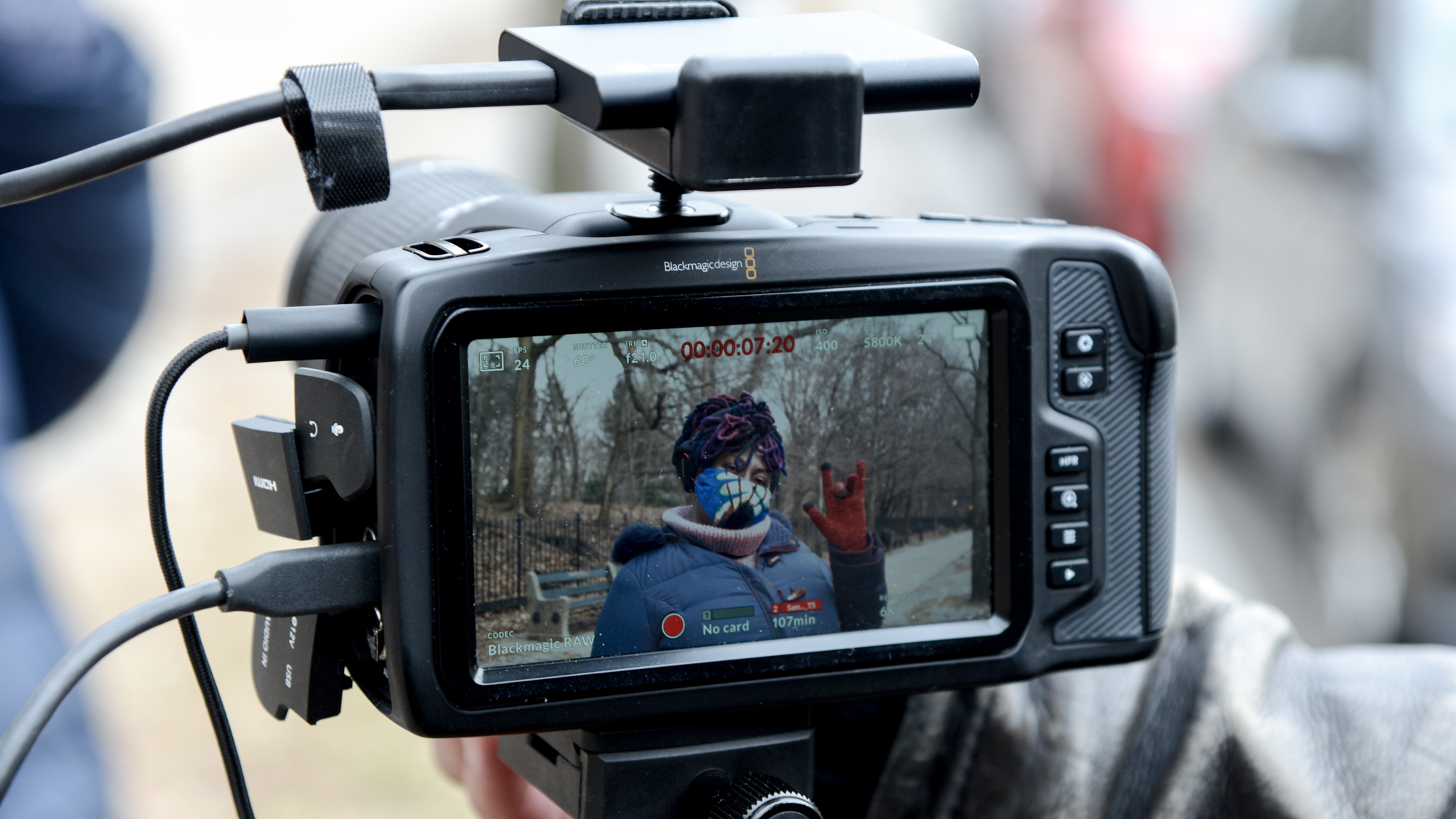
The only minor issue with the BMPC6K is that if you’re shooting outdoors in bright conditions, the screen can be a little hard to view. I found myself using my hand to shade the screen from time to time. However, you can purchase a sun hood on Amazon for under $30 that should resolve that issue. Still, we hope Blackmagic goes with a brighter display next time around.
Blackmagic Pocket Cinema 6K AutoFocus and IBIS
The Blackmagic Pocket Cinema 6K doesn’t have the autofocus system found in most cameras you can purchase today. However, the autofocus it does have is easy to use — just tap on your subject via the touchscreen. However, it won’t follow your subject and adjust focus automatically. That might be a significant issue for some, but most shooters prefer setting up shots and using manual focus anyway. Also, with the crisp clarity you get right out of the box, you’ll seldom notice the lack of smarter autofocus. I shot vlog style and was never out of focus although it would have been easier if the BMPC6K had a flip-out screen to see yourself.

There is no in-body stabilization (IBIS), but many of the Canon EF lenses provide excellent image stabilization. The lack of IBIS may be a turn-off for some, but it can present certain issues (like wavey footage distortion) as seen on certain other DSLR cameras.
You can stabilize your image nicely due to all the extra pixel information when you’re filming in 6K RAW or editing in post. Keep in mind that super shaky footage can’t be perfectly stabilized in the editing process, but you should get usable footage.
Blackmagic Pocket Cinema 6K performance
The primary difference between the BMPC6K and 4K is the resolution. The 4K has a 4/3 sensor while the 6K was leveled up to a Super 35 sensor similar in size to an APS-C sensor (smaller than a full-frame but larger than M4/3). The sensor is nearly 60% larger, which allows more light into the sensor and more image information to work with while editing. The Super 35 sensor does have a 1.5x crop which is an improvement over the 2x crop of the BMPC Cinema 4K, giving you a wider field of view, a sharper image, and better low-light performance.
With 13 stops of dynamic range and dual native ISOs, it’s also fine-tuned to handle image noise and retaining tonal detail in situations notoriously hard for video. This also means it can capture HDR content. Also, the Blackmagic Pocket Cinema 6K films natively in a 16:9 ratio unlike most traditional 3:2 aspect ratios found on multi-functional photography cameras. The BMPC6K also has built-in fans to keep things cool while you’re filming, something many multi-function DSLRs and mirrorless cameras lack.
When you’re shooting 6K video with 12-bit colors, the BMPC6K produces unbelievably flexible footage, especially when it comes to the colors. In Film mode, the dynamic range nets you some very flat-looking footage straight out of the camera. Don’t be dismayed or fooled by this flatness of color –– you want it, trust me. Shooting in Blackmagic RAW provides a ton of data stored in those files that let you push and pull the colors in any direction you please, meaning you can achieve all kinds of dramatically different looks.
I found the color science of the flat footage highly usable. All that image information granted me a ginormous range to play with. It allowed me to get many different looks from the footage from the washed-out amber aesthetic of ‘70s films to the over-saturated look of many hip-hop videos from the late ‘90s and early 2000s. I felt like I had complete control over the entire color spectrum.
One thing I noticed while viewing my footage was the out-of-this-world image quality. The Blackmagic picks up every tiny detail with a crispness that allowed me to pull high-quality still images from my videos. It made something relatively mundane look extraordinary.
The advantage of shooting in 6K is the ability to down sample the footage when you’re done editing to either 4K or 1080 HD. When you compress that 6K footage down, the oversampling will give you a significant boost in quality that you and others will notice.
Blackmagic Pocket Cinema 6K audio
The Blackmagic Pocket Cinema 6K comes with a pair of built-in stereo microphones that does a great job of capturing audio, especially if you’re in a quiet setting. However, If you’re serious about recording high-quality audio, invest in a boom mic and some lavalier mics. The microphones are suitable for syncing up audio with an external recorder.

While recording footage from three feet, the microphones picked up my voice with no tonal defects or loss of my voice’s natural deep timbre. However, when I moved it past five feet, there were some audible differences which I resolved within Fairlight, the audio editing software that comes built into the Davinci Resolve editing suite.
Blackmagic Pocket Cinema 6K battery life
The BMPC6K uses some underpowered Canon LP-E6 batteries (2,000mAh lithium-ion battery). Their limitations really become apparent when you’re shooting in 6K RAW as that huge image information eats batteries up quickly.
On average, I got 25 to 35 minutes of battery life during stop-and-start shooting. If I shut the camera off between shots, I could stretch it out, but not by much. I highly recommend purchasing extra batteries or the Battery Grip for Blackmagic, which will extend recording time for a few hours.
You also can power the camera on an external battery, which is probably a better idea. The Juicebox is one option and claims to offer three hours of battery life. The final option if you’re shooting indoors is to plug the unit plugged directly into a power source using its supplied power cord.
Blackmagic Pocket Cinema 6K software and warranty
Blackmagic cameras are known for their user-friendly UI and the same holds here. It only took minutes to figure out how to adjust my settings while using the UI via the rear touchscreen. Every option you want to adjust is as simple as a finger tap or slide. You get tight control over the Iris, ISO, or codec you want to shoot in. If you slide through the menus, you can control your audio levels or turn the built-in mics off. I also liked the ability to adjust the levels for my plugged-in external audio sources.

Davinci Resolve Studio 17 is Blackmagic’s proprietary software. It’s a fantastic video editing suite that is considered industry-wide as the best software for color grading your footage, and it comes free with your camera. Resolve takes full advantage of the Blackmagic RAW codec. I shot some footage in a 5:1 constant bitrate setting, which produced awesome footage. If you want to try to get a little more color info, you can go to the 3:1 compression, but only a pro can tell the difference.
Davinci Resolve’s UI is very familiar to anyone who has used Adobe Premiere or Premiere Elements. It makes editing the Blackmagic Raw files a cakewalk. You can also choose from many different video effects, transitions, titles, and audio transitions.
Resolve also includes Fairlight audio editing software built right into the suite as well, and it’s easily accessible. There’s also Fusion, which allows you to let your imagination go wild and create cinematic visual effects and motion graphics. It features a node-based workflow with hundreds of 2D and 3D tools.
The Blackmagic Pocket Cinema 6K comes with a 12-month Limited Manufacturer's Warranty.
Bottom line
The idea behind the Blackmagic Pocket Cinema Line of cameras is to give as many people as possible the ability to shoot cinema-quality footage at a reasonable price. Not everyone will end up becoming the next George Lucas or Spielberg; however, with a Blackmagic Pocket Cinema 6K, you are one giant step closer.
The BMPC6K is a great camera with a lot of powerful components including a Super 35 sensor, 13 stops of dynamic range, strong low light performance, 6K resolution, and plenty of ports. It’s capable of producing higher resolution and outshooting other more expensive cameras and doesn’t weigh you down or tire you out. When you add the Davinci Resolve software suite, you’re ready to start producing professional-level footage that anyone could be proud of — and all for just $1,995.
My final thought on the Blackmagic Pocket Cinema 6K is that it’s not for everyone. However, for the price and specs, it’s a must-have in my camera kit and a great option for anyone looking to shoot high-quality video, the likes of which you’d only get from more professional rigs.
Blackmagic Pocket Cinema 6K Specs
| Size | 9.1 x 9.1 x 9.1 inches |
| Display | 5-inch1920 x 1080 LCD touch screen |
| Resolution (ProRes) | 3840 x 2160 (Ultra HD), 2868 x 1512 (2.8K 17:9), 1920 x 1080 (HD) |
| Power | Lockable DC port Weipu 2-pin connector |
| Price | $1,995 |
| Battery | LP‑E6 Battery with USB-C charging |
| Construction | Polycarbonate/carbon fibre composite |
| Lens Mount | Canon EF |
| Weight | 1.98 pounds |
| Sensor | Super 35 |
| Storage | Dual SD/CFast cards, records RAW internally, external recording to USB-C drive |
| Dynamic range | 13 stops |
| Resolution (Blackmagic RAW) | (60fps) 6144 x 3456 (6K), 6144 x 2560 (6K 2.4:1), 5744 x 3024 (5.7K 17:9) (120fps) 2.8k, 1080p HD |

Mark has spent 20 years headlining comedy shows around the country and made appearances on ABC, MTV, Comedy Central, Howard Stern, Food Network, and Sirius XM Radio. He has written about every topic imaginable, from dating, family, politics, social issues, and tech. He wrote his first tech articles for the now-defunct Dads On Tech 10 years ago, and his passion for combining humor and tech has grown under the tutelage of the Laptop Mag team. His penchant for tearing things down and rebuilding them did not make Mark popular at home, however, when he got his hands on the legendary Commodore 64, his passion for all things tech deepened. These days, when he is not filming, editing footage, tinkering with cameras and laptops, or on stage, he can be found at his desk snacking, writing about everything tech, new jokes, or scripts he dreams of filming.
